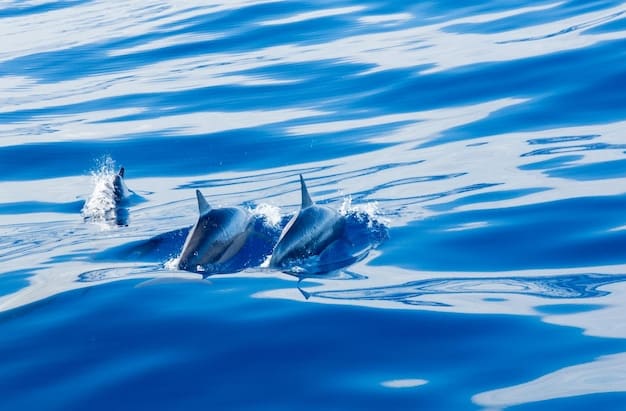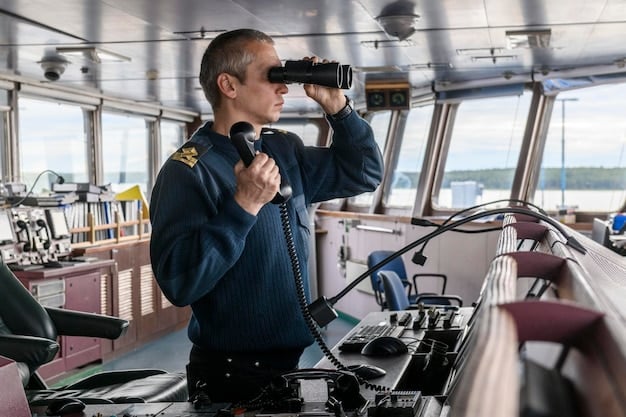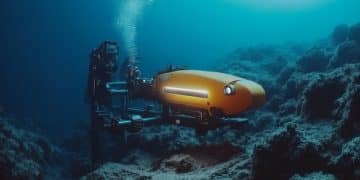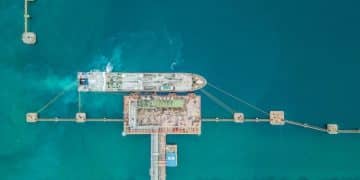Ethical Considerations of Marine Animal Tourism in US

Navigating the ethical complexities of marine animal tourism in the US demands a deep understanding of animal welfare, environmental impact, and economic sustainability, balancing human interaction with conservation to ensure responsible practices for both marine life and human engagement.
Diving into the discussion of What are the Ethical Considerations of Marine Animal Tourism in the US? uncovers a complex interplay between thrilling human experiences and the delicate well-being of marine life. This exploration aims to shed light on the multifaceted challenges and responsibilities inherent in these popular attractions, inviting a deeper look into our role as visitors and stewards of the ocean.
The Intersection of Conservation and Commerce
Marine animal tourism, ranging from whale watching to swimming with dolphins, has become a global phenomenon, drawing millions of enthusiasts annually. In the US, coastal states thrive on this industry, attracting tourists eager to witness charismatic marine species in their natural habitats. However, this economic driver is inextricably linked to significant ethical considerations that demand careful scrutiny. The fundamental challenge lies in balancing commercial interests with the imperative of marine conservation and animal welfare.
When businesses prioritize profit over ecological stewardship, the consequences can be severe. Unregulated interactions can disrupt feeding patterns, breeding cycles, and social structures of marine animals, leading to long-term ecological damage. The pressure to provide close encounters often pushes operators to disregard established guidelines or pursue interactions that are inherently stressful for the animals involved. This commercial impetus frequently creates a tension with conservation goals, leading to a critical need for robust regulatory frameworks and ethical practices.
Direct Impact on Marine Species Behavior
The presence of tourism vessels and human activity can undeniably alter the natural behaviors of marine animals. Repeated noisy approaches or close proximity can cause stress, leading to changes in their foraging habits, migratory routes, and even reproductive success. Marine mammals, in particular, rely on sound for communication, navigation, and hunting, making them highly vulnerable to acoustic disturbances from boats.
- Behavioral Disruption: Animals may cease feeding, rest, or socializing due to human presence.
- Habitat Displacement: Repeated disturbances can force animals to abandon preferred habitats.
- Increased Stress Levels: Chronic stress can weaken immune systems and reduce reproductive success.
Further, some interactive tourism activities, such as swimming with certain species, can habituate animals to human presence, making them more susceptible to negative interactions with boats or fishing gear. This habituation can also lead to dependency, where animals start associating humans with food, potentially altering their natural foraging instincts and making them bold towards human interaction in unsafe ways.
Defining Responsible Tourism
Defining responsible marine animal tourism involves a commitment to minimizing negative impacts while actively contributing to conservation efforts. It encompasses adherence to regulations, educating participants, and supporting scientific research. True responsible tourism goes beyond simply avoiding harm; it seeks to generate positive outcomes for marine ecosystems and local communities.
Operators committed to responsible practices often engage in voluntary self-regulation, implementing stricter codes of conduct than legally required. They prioritize the safety and well-being of the animals above all else, ensuring that interactions are brief, respectful, and non-intrusive. Additionally, many responsible tourism operations contribute a portion of their earnings to conservation initiatives, directly funding research and protection programs for the very species their businesses rely upon.
Regulatory Frameworks and Their Efficacy
In the US, various regulations and guidelines are in place to govern marine animal tourism, primarily to protect marine mammals under acts like the Marine Mammal Protection Act (MMPA) and the Endangered Species Act (ESA). These laws prohibit harassment, hunting, capture, or killing of marine mammals and aim to conserve endangered or threatened species and their habitats.
However, the efficacy of these frameworks often varies. Enforcement can be challenging due to vast coastal areas, limited resources, and the transient nature of marine animal populations. While the spirit of the law is to protect, breaches do occur, whether due to ignorance, negligence, or deliberate disregard for regulations. This highlights the ongoing need for robust monitoring and consistent enforcement to ensure compliance.
Challenges in Enforcement and Compliance
Despite clear regulations, several factors impede effective enforcement. The sheer volume of tour operators and vessels in popular destinations makes comprehensive oversight difficult. Additionally, identifying and proving harassment can be complex, as it often involves subtle behavioral changes in animals that might not be immediately obvious or easily documented. Many incidents go unreported or are difficult to prosecute due to lack of definitive evidence.
- Resource Limitations: Insufficient funding for regulatory agencies and patrol boats.
- Data Collection: Difficulty in consistently monitoring and documenting violations.
- Public Awareness: Lack of knowledge among tourists and some operators regarding regulations.

Furthermore, self-regulation within the industry, while commendable in some instances, is not universally adopted. Operators who prioritize short-term profits might disregard guidelines, creating an uneven playing field and potentially undermining the efforts of responsible businesses. This uneven compliance creates a need for educational outreach, not just to tourists, but also to operators who might benefit from a deeper understanding of sustainable practices and their long-term benefits.
Role of Education and Certification
Education plays a pivotal role in bridging the gap between regulatory intent and real-world practice. Educating tourists about respectful viewing distances and the impact of their presence can empower them to choose responsible operators and report non-compliant behavior. Similarly, operators benefit from ongoing training and certification programs that keep them abreast of best practices and conservation science. Certification programs, often run by non-governmental organizations or industry associations, can set higher standards for ethics and sustainability, offering a mark of distinction for environmentally conscious businesses.
These programs typically cover topics such as marine mammal biology, responsible viewing guidelines, emergency response, and the importance of minimizing ecological footprint. By participating in such programs, operators not only enhance their credibility but also foster a culture of conservation within their own businesses. This proactive approach by the industry itself can significantly contribute to better outcomes for marine life. However, these programs are only effective if they are widely adopted and rigorously enforced by their governing bodies.
Animal Welfare in Encounters and Captivity
The question of animal welfare extends beyond direct encounters in the wild to encompass facilities that house marine animals for tourism purposes, such as aquariums and marine parks. While proponents argue that these facilities offer educational opportunities and contribute to conservation through research and rescue, critics raise significant ethical concerns regarding the confinement of intelligent, wide-ranging species in artificial environments. The ethical debate surrounding marine animal tourism is intensified when considering animals in captivity.
The environments provided in these facilities, even the most modern ones, rarely replicate the complexity and size of natural oceanic habitats. This can lead to a range of welfare issues, including stereotypic behaviors indicative of stress, aggression among confined animals, and reduced lifespans in some species. The debate often centers on whether the educational and conservation benefits outweigh the inherent compromises to animal well-being.
Ethical Implications of Captivity
Housing marine animals, particularly highly migratory and social species like dolphins and whales, in captivity raises serious ethical questions. These animals often possess complex cognitive abilities, intricate social structures, and require vast spaces for natural behaviors. Confining them to tanks, no matter how large, fundamentally restricts these aspects of their lives. This can result in chronic stress, boredom, and a lack of proper stimulation, leading to compromised welfare states.
- Spatial Restrictions: Tanks limit natural swimming, diving, and exploration.
- Social Deprivation: Artificial groupings can disrupt natural social dynamics.
- Behavioral Stereotypies: Repetitive, non-functional behaviors indicating stress.
The practice of breeding marine animals in captivity for entertainment purposes also draws ethical scrutiny. Critics argue that this perpetuates a cycle of confinement and that such breeding programs do not genuinely contribute to the conservation of wild populations. Instead, they contend that resources should be directed towards protecting natural habitats and addressing threats in the wild.
Distinguishing Responsible Aquariums and Marine Parks
Not all captive facilities are created equal. Responsible aquariums and marine parks prioritize animal welfare, robust conservation programs, and genuine scientific research over public entertainment. They invest heavily in large, complex habitats, enriched environments, and dedicated veterinary care. Such facilities often participate in Species Survival Plans (SSPs) and contribute significantly to scientific understanding of marine life.
Key indicators of responsible practice include accreditation by professional bodies, transparent reporting on animal welfare, and a clear focus on education that inspires conservation rather than merely showcasing animals. These facilities often serve as crucial rescue and rehabilitation centers for injured or stranded marine animals, providing a vital service that directly benefits wild populations. Their educational exhibits can raise public awareness about marine conservation issues, potentially offsetting some of the ethical concerns about captivity.
Economic Benefits Versus Ecological Costs
Marine animal tourism undeniably injects significant revenue into local economies across the US. It supports jobs in various sectors, from boat operators and guides to hospitality and retail. For many coastal communities, this industry represents a crucial component of their economic livelihood. This economic prosperity, however, must be weighed against the potential ecological costs associated with the industry.
The “cost” extends beyond direct harm to individual animals to include broader ecosystem impacts. Increased boat traffic contributes to noise pollution, air pollution from exhaust, and the risk of vessel strikes. Anchorage in sensitive areas can damage seabeds and coral reefs. Uncontrolled waste disposal from tourism operations can also pollute marine environments. Balancing these economic benefits with the necessity of preserving the ecological integrity of marine environments is a perpetual challenge that requires proactive strategies.
Sustainable Economic Models
Developing sustainable economic models for marine animal tourism is crucial for its long-term viability. This involves practices that not only minimize environmental impact but also reinvest in conservation and local communities. Ecotourism certification programs, for example, can guide operators towards more sustainable practices, which in turn can attract environmentally conscious tourists willing to pay a premium for ethical experiences.
Revenue generated from tourism can be channeled back into marine protected areas, scientific research, and community-based conservation initiatives. This creates a virtuous cycle where the very act of tourism contributes to the health and sustainability of the marine environment it depends upon. Diversifying tourism offerings beyond direct animal encounters, such as educational tours focused on coastal ecology or snorkeling in non-sensitive areas, can also reduce pressure on vulnerable species.
Mitigating Environmental Footprint
Reducing the environmental footprint of marine animal tourism requires a multi-faceted approach. This includes adopting cleaner energy sources for vessels, implementing strict waste management protocols, and carefully planning routes to avoid sensitive habitats. Encouraging tourists to respect marine ecosystems, by not littering or disturbing wildlife, is also a vital component of mitigation efforts.
Technological advancements, such as quieter engines and propeller guards, can also help minimize disturbance and injury to marine life. Furthermore, ongoing research into the long-term effects of tourism on specific marine populations is essential for developing adaptive management strategies that can respond to new findings and ensure the continuous improvement of sustainable practices. Collaboration between operators, scientists, and regulatory bodies holds the key to achieving positive outcomes.

The Role of the Tourist: Responsible Choices
Ultimately, a significant ethical responsibility lies with the tourist. Consumer demand shapes the industry, and by making informed, responsible choices, tourists can drive positive change. Choosing accredited, ethical operators sends a clear message to the market: sustainability and animal welfare are priorities. Conversely, supporting irresponsible operators inadvertently contributes to practices that endanger marine life.
Before booking any marine animal tourism activity, individuals should research the operator’s reputation, their adherence to regulations, and their commitment to animal welfare. Questions to ask include their viewing distance policies, whether they guarantee sightings (a red flag for potential harassment), and if they contribute to conservation efforts. The collective power of conscious consumerism can be a potent force for ethical improvement within the industry. It’s about being an active participant in conservation, not just a passive observer.
Informed Decision-Making
Making informed decisions as a tourist involves more than just checking a company’s website. It requires delving into reviews, seeking out third-party accreditations, and understanding the local regulations for marine animal interactions. Organizations like the Whale SENSE program in the US, for instance, certify whale watching operators who adhere to responsible viewing guidelines and educate passengers.
Tourists should also be aware of the ethical implications of activities that involve direct contact with wild animals, such as feeding or swimming with certain species, unless conducted under strictly controlled research and rehabilitation efforts. Such interactions can lead to habituation, dependency, or even aggression, compromising both human safety and animal welfare. A truly informed decision prioritizes the animals’ well-being over a fleeting human desire for close contact.
Advocacy and Support for Conservation
Beyond choosing responsible operators, tourists can become active advocates for marine conservation. This can involve supporting marine protected areas, contributing to organizations working on marine animal rescue and rehabilitation, or simply spreading awareness about the ethical considerations of marine tourism. Every voice, no matter how small, adds to the collective effort to protect our oceans.
Participating in citizen science projects, reporting observed violations, or even engaging in constructive dialogue with tour operators about their practices are all ways individuals can contribute. The future of marine animal tourism, and the health of our oceans, depends on a shared commitment to ethical principles and proactive conservation. It’s not just about what we take from the ocean, but what we give back to ensure its vitality for generations to come. This holistic approach ensures that tourism is a tool for conservation, not a detriment.
Future Directions: Technology, Research, and Policy
The future of ethical marine animal tourism in the US will heavily rely on advancements in technology, continued scientific research, and adaptive policy-making. New technologies, such as drones for non-invasive monitoring and acoustic tracking devices, can provide richer data on marine animal behavior and reduce the need for close physical approaches. This allows for observation with minimal disturbance, offering valuable insights into populations without compromising their well-being.
Ongoing research is essential for understanding the long-term impacts of tourism on specific species and ecosystems, enabling policy-makers to refine regulations based on the latest scientific evidence. As marine environments continue to face new threats from climate change and pollution, research will also inform how tourism can adapt to minimize its synergistic impacts. This proactive approach is critical for the adaptation and resilience of marine life.
Technological Innovations for Minimizing Impact
Technology offers promising solutions for reducing the ecological footprint and behavioral disturbances associated with marine animal tourism. Developments in electric propulsion systems for boats can significantly reduce noise pollution and carbon emissions, making tours quieter and cleaner. Underwater drones equipped with cameras and sensors can capture stunning footage and gather data without physically entering critical habitats or disturbing animals.
- Silent Propulsion Systems: Reduces acoustic stress on marine life.
- Remote Observation Tools: Drones and underwater ROVs allow distant monitoring.
- AI-Powered Monitoring: Helps identify animal behavior patterns and potential impacts.
Virtual reality and augmented reality technologies also present an exciting frontier, offering immersive educational experiences that recreate marine environments and interactions without any direct impact on wild animals. These technologies can serve as powerful tools for raising awareness and fostering appreciation for marine life among those who may not have the opportunity to experience it in person, thereby mitigating the pressure for direct, potentially harmful encounters.
Adaptive Management and Policy Revision
Effective management of marine animal tourism requires a flexible and adaptive approach, continually revising policies based on new scientific findings and changing environmental conditions. This means that regulations should not be static; instead, they should be reviewed periodically and adjusted to reflect the most current understanding of marine ecology and animal welfare. An adaptive framework allows for swift responses to emerging threats or unforeseen impacts.
Collaboration among government agencies, scientific institutions, tourism operators, and conservation organizations is vital for this adaptive process. Shared data, joint research initiatives, and open dialogue can lead to more effective and widely accepted policies. Ultimately, the goal is to create a tourism model that is resilient, environmentally sound, and contributes positively to the conservation of the US’s invaluable marine heritage. This forward-looking approach ensures the industry can evolve sustainably.
Conclusion: Charting a Course for Ethical Marine Tourism
Addressing What are the Ethical Considerations of Marine Animal Tourism in the US? reveals a landscape where economic viability, human enjoyment, and environmental stewardship must coexist in delicate balance. From understanding behavioral impacts to strengthening regulatory frameworks and fostering responsible consumption, the path forward requires a concerted effort from all stakeholders. By prioritizing animal welfare and robust conservation practices, marine animal tourism can transcend mere entertainment to become a powerful force for global ocean stewardship.
| Key Aspect | Brief Description |
|---|---|
| 🐳 Animal Welfare | Ensuring tours don’t disrupt marine behavior or cause stress; addressing captivity ethics. |
| ⚙️ Regulatory Efficacy | The challenges and successes of enforcing protective laws like the MMPA. |
| 💰 Economic vs. Eco Cost | Balancing tourism revenue with environmental impacts like noise and pollution. |
| 🧑🤝🧑 Tourist Responsibility | The power of informed choices and advocacy in supporting ethical operations. |
Frequently Asked Questions
▼
Primary ethical concerns involve potential harm to marine animals through behavioral disruption, habitat displacement, and increased stress levels due to human presence and vessel traffic. Additionally, the ethics of keeping highly intelligent and migratory species in captivity for entertainment purposes are frequently debated, raising questions about animal welfare in artificial environments.
▼
The Marine Mammal Protection Act (MMPA) and the Endangered Species Act (ESA) are key US regulations prohibiting harassment or harm to marine mammals and protecting endangered marine species. These laws establish guidelines for minimum viewing distances, speed limits for vessels, and other operational procedures to minimize disturbance and ensure responsible interactions.
▼
Yes, tourism activity can impact marine ecosystems significantly. Increased boat traffic contributes to noise pollution, which interferes with marine animal communication and navigation. Fuel emissions can degrade water quality, and direct human interaction can alter feeding patterns, leading to dependency or increased vulnerability to boat strikes and other human-induced threats. These impacts can ripple through the entire ecosystem.
▼
Tourists can ensure ethical participation by choosing operators accredited by reputable conservation organizations. They should research companies’ policies regarding animal welfare, respectful viewing distances, and their contributions to conservation. Avoiding companies that guarantee sightings or encourage direct physical interaction with wild animals is also crucial, as these practices often indicate a disregard for animal welfare.
▼
Technology aids ethical marine tourism by enabling non-invasive observation through drones and acoustic monitoring, reducing the need for close human proximity. Electric propulsion systems can decrease noise and pollution. Virtual and augmented reality also offer immersive educational experiences that foster appreciation for marine life without disturbing natural habitats, promoting awareness and inspiring conservation efforts broadly.
Conclusion
The intricate balance between experiencing the majesty of marine life and ensuring its preservation is at the heart of the ethical considerations surrounding marine animal tourism in the US. By fostering stricter regulations, encouraging sustainable economic models, leveraging technological advancements, and empowering tourists to make informed choices, we can steer this industry towards a future where both human enjoyment and marine conservation thrive. Our collective actions determine whether these encounters remain a source of wonder or become a threat to the very creatures they celebrate.





